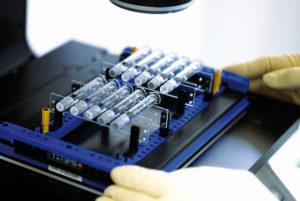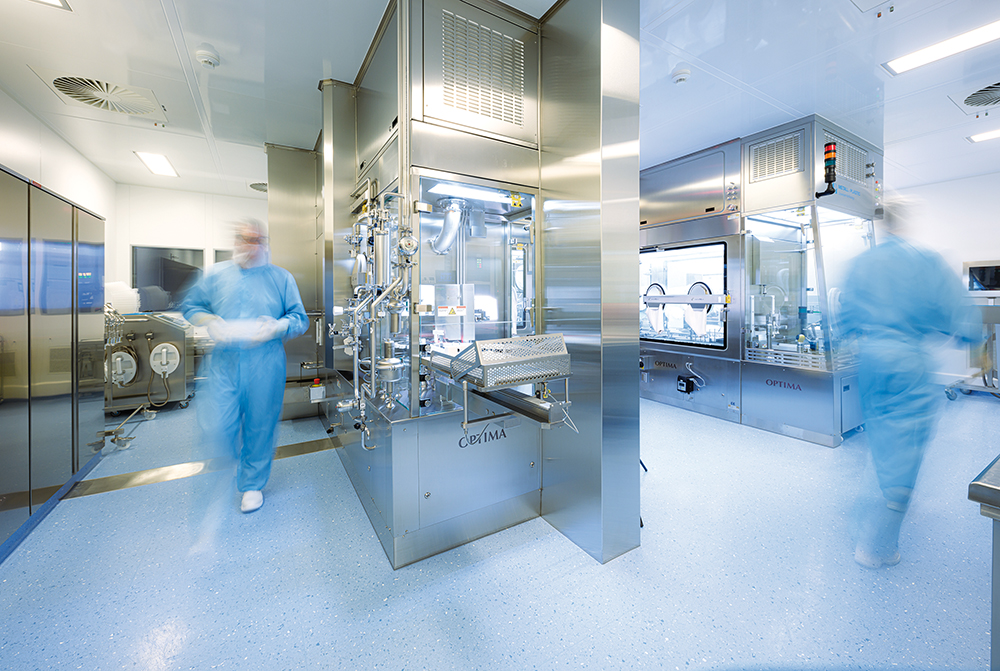To Issue 157
Citation: Allmendinger A, Mahler H-C, Behrendt P, “Addressing Intravitreal Product Manufacturing and Development Challenges”. ONdrugDelivery, Issue 157 (Mar 2024), pp 29–32.
Andrea Allmendinger, Hanns-Christian Mahler and Philipp Behrendt discuss the challenges of filling very small volumes into syringes for intravitreal injections, and how ten23 health’s innovative filling technology can help combat the critical issue of air bubble formation.
Previously in ONdrugDelivery, ten23 health has discussed the need for a profound, holistic understanding of product and manufacturing processes, both current and emerging, as well as regulatory and quality requirements for intravitreal (IVT) applications; the need for cutting-edge manufacturing technologies; and for expertise in the production of ophthalmic products. These elements are crucial for ensuring patient safety, compliance with regulatory standards and minimising costs. In this article, ten23 showcases how the company’s aseptic manufacturing services at its innovative and highly adaptable automated, isolator-based good manufacturing practice (GMP) filling line in Visp, Switzerland, effectively address the intricate demands and technical challenges encountered in the development and manufacture of IVT preparations, with a special focus on the filling volume in relation to the injection volume.
INJECTION VOLUME AND PRIMARY PACKAGING CONTAINER SELECTION
“Although there are reports of injection volumes reaching as high as 100 μL, limited information exists regarding the upper limit for injectable volume into the back of the eye.”
IVT preparations are typically supplied in a 0.5 mL, or sometimes 1 mL, prefilled syringe configuration, in most cases with a Luer lock. However, IVT applications commonly involve injection volumes ranging from 25 to 50 μL. Although there are reports of injection volumes reaching as high as 100 μL, limited information exists regarding the upper limit for injectable volume into the back of the eye.1
Because IVT administration volumes often fall well below the minimum fill volumes achievable by most sterile facilities and contract manufacturing organisations, IVT products are often significantly overfilled. As such, the end-user, usually a healthcare professional, may need to manipulate syringes for IVT use by expelling any potential air and liquid formulation to reduce the contents of the syringe down to the target administration volume, made visible with graduation marks, in a practice known as “down-dosing”. For instance, syringes filled with a target fill volume of 100 μL may need to be down-dosed to a target injection volume of 50 μL. However, down-dosing presents a precision challenge for users in terms of accuracy, introduces the risk of variability in administered volume and leads to significant API losses – generating substantial product waste, which adversely impacts the overall cost of goods.
The precision of the injection device typically defines the lower limit of the injected volume, and syringes intended for IVT injection must undergo thorough characterisation to ensure dosing accuracy. The lower limit of dosing currently stands at approximately 10 μL for conventional syringes, depending on the graduation marks and the proficiency of the intended users. In particular, the absence of an air bubble in the syringe is highly desirable from a user perspective, as down-dosing may become considerably more challenging if one is present. For injectable products not undergoing down-dosing, the essential absence of any headspace is additionally relevant from a patient safety perspective, as the injection of air is generally undesirable. Furthermore, an air bubble can provide further challenges, such as during air transport or downstream processes using pressure differentials.

Figure 1: Ready-to-use primary packaging containers, such as syringes, are common for combination products.
Combination products are typically filled in ready-to-use primary packaging containers, such as syringes (Figure 1), often in nest/tub configurations. This implies that the container is delivered pre-washed, pre-sterilised and ready for filling by the supplier. However, this necessitates that device attributes meet the final drug product requirements throughout the supply chain until the filling point. This includes device performance and safety-relevant parameters, ensuring the absence of micro-organisms (maintenance of sterility), compliance to endotoxin limits and prevention of potential contaminants, such as particles.
The introduction of novel containers into the market has increased, requiring a comprehensive characterisation of such primary packaging containers and their compatibility with the product. Essentially, the characterisation of primary components with the final product’s quality in mind is crucial. This involves comprehensive assessments, including extractables and leachables testing, container closure integrity and product quality evaluations, such as particle contamination.
Stability testing of the product filled into primary containers covers various biochemical and pharmacopeial endpoints, addressing critical quality attributes (CQAs) such as content and purity, along with obligatory CQAs, including both sub-visible and visible particulates. In addition, novel containers must be assessed for their manufacturability and whether they reliably deliver a reproducible quality of output. Critical material attributes can often be identified as a result of such manufacturing process assessments.
“The introduction of novel containers into the market has increased, requiring a comprehensive characterisation of such primary packaging containers and their compatibility with the product.”
FILL-FINISH PROCESS – SMALL-VOLUME, BUBBLE-FREE FILLING
From a technical perspective, filling small volumes into primary packaging containers during fill-finish operations is challenging both from an accuracy and a visual inspection perspective. Filling of small volumes well below 1 mL is typically achieved by the selection of adequate filling technologies. While piston pumps have traditionally been believed to be the most suitable technology for achieving high precision, nowadays, very-low-volume positive-displacement pumps, such as peristaltic pumps, are typically preferred over piston-pump systems. Additionally, peristaltic pumps are more compatible with biologics.2
Novel pump systems, such as liner peristaltic pumps, which have been suggested to be superior in terms of filling accuracy for small volumes, have not yet become standard in filling systems. Alternative time-pressure systems have drawbacks in terms of filling accuracy, especially at low volumes and for highly viscous products, because of potential air bubble formation and the temperature dependency of the fill volume.
Besides dosing accuracy, the selection of the filling technique depends on numerous parameters, including operational and maintenance considerations, the availability of the pump system at the manufacturing site and associated investment plans. It is also important to consider the impact of the product of factors – such as the minimisation of interfacial stresses for biological product solutions or wear and tear (including shedding).2
Most filling technologies, including peristaltic pump systems, use volumetric dosing based on optimised filling pump parameters that operate within defined alarm and action limits. As a gold standard and to increase filling accuracy, these limits are typically coupled to a feedback loop that measures the fill weight of the individual product by weighing the differential of the product vial pre- and post-fill. In some instances, fill volumes are controlled by weight up to 100%. In other cases, the feedback loop even allows for re-dosing, omitting sole reliance on volumetric methods.
As already discussed, the presence of an air bubble in an IVT syringe may create significant challenges during down-dosing and for dosing accuracy. The challenge persists during air transport, emphasising the importance of the design of the fill volume and allowable headspace in relation to the chosen primary packaging and stopper. Transport conditions may induce stopper movement due to pressure changes, potentially compromising container closure integrity. Movement of the air bubble in the syringe during transport may also cause additional interfacial stress to the product, which can be detrimental for product quality. Furthermore, terminal sterilisation, if affected by pressure changes, may become critical depending on the headspace in the syringe. Therefore, achieving a bubble-free plunger setting at the manufacturing facility, allowing for minimal headspace, may be crucial.
High-precision bubble-free and low-volume filling technology is a key asset of ten23 (Figure 2), with a combination of appropriate stopper placement techniques and adequate pressure settings. This approach eliminates many challenges observed in slip-stoppering, is applicable for coated stoppers and is preferable for high-viscosity biologics, such as ophthalmic medicines. The advantages of bubble-free filling include high dosing accuracy, as the syringe orientation does not affect the dosage delivery; greater sterility assurance, as there is a much less chance of plunger movement during shipping; better biological stability regarding product headspace interaction; and less chance of needle dripping after needle shield removal.

Figure 2: ten23’s facilities include the capability for highly accurate, air-bubble-free filling of very low-volume primary containers in isolators operated in class C.
“High-precision bubble-free and low-volume filling technology is a key asset of ten23, with a combination of appropriate stopper placement techniques and adequate pressure settings.”
Besides the challenges associated with accurately filling small volumes, any challenges related to visual inspections are especially apparent with IVT products. Especially in vial configurations, they often feature a meniscus just slightly above the container bottom, making it difficult for visual inspection operators to detect visible particles, especially if solution and formulation present further challenges for visibility, such as opalescence. Small filling volumes are equally difficult for automated visual inspection.
CONCLUSION
ten23 possesses the capability to precisely fill very small volumes for IVT applications based on the company’s innovative filling technology, avoiding the presence of an air bubble and minimising product loss. During product development and manufacturing, ten23 fosters the alignment between drug product manufacturing capabilities and the specifications of the device partner and primary packaging supplier to ensure compliance with all agreed parameters.
REFERENCES
- Parenky AC et al, “Container Closure and Delivery Considerations for Intravitreal Drug Administration”. AAPS PharmSciTech, 2021, Vol 22(3), Article 100.
- Adler M, Allmendinger A, “Filling Unit Operation for Biological Drug Products: Challenges and Considerations”. J Pharm Sci, 2024, Vol 113(2), pp 332–344.

